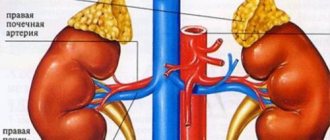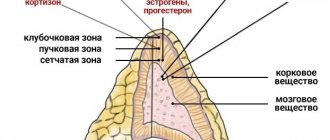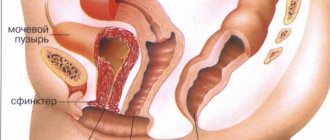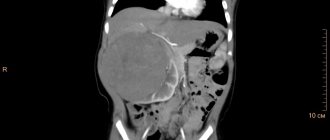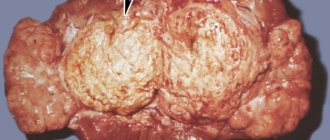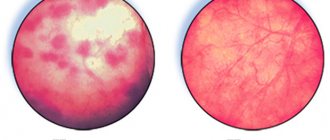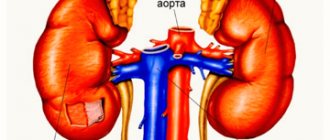Causes
Adrenal adenoma in women or men is not recorded very often. Why does the disease develop at all? There may be several reasons for this:
- some patients have a genetic predisposition to this type of tumor;
- the patient does not struggle with his excess weight;
- some hormonal changes may explain the appearance of adrenal adenoma in women;
- addiction to alcohol or smoking;
- the presence of other somatic diseases associated with problems in the body’s hormonal system (hypo- and hyperthyroidism, damage to the pituitary gland, diabetes mellitus).
Symptoms of adrenal adenoma
Signs and further therapy of a benign tumor are directly dependent on the degree of activity, size and predisposition to further growth. The described neoplasm in women usually has a small diameter, so it does not injure the tissue, blood vessels and nerve endings around it.
Adrenal adenoma does not cause any obvious medical manifestations. Most often, a tumor is discovered by a doctor unintentionally, during a magnetic resonance or computed tomography scan. An adenoma in women can be detected during an ultrasound examination prescribed for some reason.
An enlarged and developing tumor is accompanied by various specific symptoms in women, which include:
- manifestation of shortness of breath;
- sudden weight gain;
- profuse sweating;
- pain in the abdominal region and lower back;
- unreasonable hardening of the voice;
- persistent menstrual irregularities;
- sharp growth of coarse hair on the chest and face;
- thinning of the skin;
- muscle atrophy;
- protrusion of the abdomen;
- stretch marks of burgundy or bluish shades;
- depression;
- emotional or mental inhibition;
- manifestation of diabetes mellitus;
- high blood pressure;
- pronounced swelling;
- convulsions;
- reduction in the volume of the mammary glands.
Kinds
Identified adrenal adenoma in men or women should be classified. First of all, the doctor classifies the pathology as a hormone-producing or non-producing type.
Tumors that do not produce hormones are more common. They are also called "silent".
If the growing tissues release any substances, it is necessary to determine their nature. Based on the detection of the secreted hormone, they are distinguished:
- corticosteromas, which produce various glucocorticosteroids;
- corticoesteromas producing estrogens;
- aldosteromes, which produce mineralocorticoids;
- androsteromes, which, in contrast to corticoesteromes, produce male sex hormones;
- mixed, highlighting several different products at once.
Additionally, all adrenal adenomas are divided into pigmented, oncocytic or adrenocortical adenomas.
Structure of the adrenal glands
These glands are similar in weight and size, but have different shapes: the right one is pyramidal, the left one is crescent-shaped. They are small in size, with a total weight of 12 g. They begin to form in the embryo at the 3rd week of pregnancy, and at the beginning of the 3rd month they already produce some hormones. They are finally formed in a child at 3 years of age.
Each of the adrenal glands consists of a cortex and medulla, each part is responsible for the synthesis of certain hormones.
Brain substance:
- adrenalin,
- norepinephrine,
- group of peptides.
Adrenaline (epinephrine) is released into the human blood during stress; in a calm state it is released in small quantities. Affects the transmission of nerve impulses, pulse and blood pressure.
Adrenal cortex:
- mineralcorticodes,
- glucocorticoids,
- sex hormones.
The cortex is located under the capsule and occupies 90% of the mass of the gland. It is divided into 3 zones: glomerular, fascicular, and reticular.
The glomerular part secretes hormones (aldosterone and corticosterone) that are responsible for mineral metabolism, removing excess fluid from the body, and helping to maintain normal blood pressure.
The fascicular part - hormones (glucocorticosteroids) - regulators of protein, fat and carbohydrate metabolism, are involved in the suppression of inflammatory reactions, and influence other processes in the body.
The reticular part of the cortex is responsible for the synthesis of sex hormones and the formation of secondary sexual characteristics.
The medulla and adrenal cortex are responsible for the most important processes in the body. The adrenal glands are interconnected with other components of the endocrine system, disruption of the normal functioning of which affects the entire human body.
Types of diseases:
- Congenital.
- Pathogenic.
- Hyperfunction of the adrenal glands.
- Pheochromocytoma.
Symptoms
It is not enough to know the cause of adrenal adenoma, but it is also necessary to detect the presence of a tumor. Symptoms of adenoma will help your doctor suspect the disease, including:
- obvious excess body weight, even despite the correct diet;
- excessive development of male or female secondary sexual characteristics, which is associated with the production of estrogens or androgens;
- various disorders of the heart and blood vessels (frequent attacks of headaches, arrhythmias, etc.);
- development of osteoporosis (increased fragility of bone tissue, which leads to frequent fractures);
- various problems with the kidneys (increased diuresis at night, when the tumor is actively manifesting itself, is considered especially important).
It does not matter whether the damage occurs to the right adrenal gland or the left. In any case, the symptoms will be similar, but you cannot rely only on them when making a diagnosis.
Because the adrenal glands produce a large number of different hormones, a left adrenal adenoma, for example, can present with completely different symptoms in two different people.
Signs of an adrenal tumor in girls and women
Only during growth and development does the adenoma begin to masculinize and disrupt female hormonal levels. If treatment is not started in time, the consequences will be irreversible. As the tumor develops, the level of aldosterone begins to increase, and the first symptoms of Cushing's or Cohn's syndromes appear.
Visually, during hormonal disorders, women's appearance changes, they become masculine. In girls and young girls, a tumor of the right or left adrenal gland is expressed through the following symptoms:
- delayed breast development;
- amenorrhea;
- growth in the size of the clitoral area;
- manifestation of rough timbre;
- accelerated puberty;
- the appearance of a sexual characteristic of the male subtype.
During Cushing's syndrome, rounding of the facial area, fullness, and enlargement of the chest are noticeable. Only a specialist can diagnose a tumor, and after an examination, he will select the optimal treatment. Adenoma in women causes metabolic disorders, abnormalities in the functioning of the heart and vascular system.
Adrenal adenoma may reappear after the removal procedure if not all metastases were removed. Therefore, in cases where symptoms have resumed, it is necessary to visit an endocrinologist for further diagnosis of the pathology. The doctor may prescribe medication or repeat surgery. The patient’s well-being is gradually deteriorating, as unstable hormonal levels provoke increased fatigue and weakness.
Diagnostics
With adenoma, a very diverse clinical picture develops, which makes it very difficult to make a diagnosis based only on symptoms. In this regard, it is necessary not only to ask the patient about complaints, but also to conduct instrumental and laboratory tests.
First of all, the patient is recommended to donate blood for analysis. The blood levels of hormones such as cortisol and aldosterone are assessed. If there is an increase in them, it means that the tumor not only exists, but it is also hormonally active.
Instrumental methods are used when it is necessary to clearly understand where the tumor is located, what size and shape it is. To clarify these parameters, ultrasound, CT and MRI are used. Using one of these methods, in most cases it is possible to obtain all the necessary data.
To anticipate such consequences of the disease as its degeneration into a malignant neoplasm, it is recommended to perform a biopsy. In this procedure, a piece of abnormal tissue is taken and examined under a microscope for cellular atypia.
How does the disease manifest in women?
Symptoms of adrenal adenoma depend on the size of the tumor itself and its ability to produce certain hormones. If the neoplasm is hormonally inactive, then it may not manifest itself in any way. In addition, symptoms appear when the tumor grows to 3-4 cm. Taking into account the type of hormones produced, the following adrenal adenomas are distinguished:
- Corticosteroma – produces cortisol.
- Corticoestroma - synthesizes estrogens.
- Androsterome - produces sex steroids.
- Aldosterome – synthesizes aldosterone.
Article on the topic: Hydrocortisone - instructions for use
Corticosteroma
The development of corticosteroma is indicated by symptoms characteristic of Itsenko-Cushing syndrome. In women, such adenoma develops at the age of 20-40 years. Due to the fact that a large amount of cortisol enters the blood, the patient develops the following symptoms:
- accumulation of excess body weight;
- osteoporosis;
- the face takes on a rounded shape;
- very thin arms in the area of the hands;
- fat deposition in the chest, neck, face, abdomen;
- atrophy of the muscles of the shoulders, abdominal wall, buttocks, legs;
- stretch marks and hemorrhages on the skin;
- menstruation disorders;
- drowsiness;
- multiple spinal fractures;
- infertility.
Aldosteroma
With the development of aldosteroma, increased production of the hormone aldosterone is observed. This causes the development of hyperaldosteronism. Characteristic signs of aldosteroma:
- muscle weakness;
- convulsions;
- arrhythmia;
- blurred vision;
- headache;
- aching pain in the heart area;
- increased fatigue;
- paresthesia.
Androsteroma
This type of tumor causes the production of male hormones. As a result, the woman develops symptoms of masculinization and other signs characteristic of men. The most common manifestations of androsteroma:
- increased male pattern hair growth;
- change in voice, which becomes rougher;
- deposition of fat in places characteristic of men;
- reduction of mammary glands;
- menstrual irregularities.
Treatment
How to treat the disease and is therapy possible with folk remedies, without drugs or surgery? The first thing you need to understand is that this disease cannot be treated with folk remedies. Both a visit to the doctor and, in most cases, surgical intervention will be required.
Today there are three main methods of conducting operations:
- for tumors of both adrenal glands, open abdominal surgery is performed, which, although traumatic, can eliminate even symmetrical pathology;
- for unilateral neoplasms, a laparoscopic technique is used, in which removal is carried out using special instruments inserted into the abdominal wall through small incisions;
- Lumbar surgery is a modern and reliable way to solve the problem, characterized not only by high effectiveness, but also by low trauma.
The choice of the optimal method remains with the doctor, who must assess possible complications of the operation, the general condition of the patient, and the severity of the disease.
Diagnostic procedures
Diagnosis of adrenal adenoma involves examining the organ using the ultrasound method. Ultrasound of the abdominal cavity is sometimes uninformative. In this case, computed tomography or magnetic resonance imaging is prescribed.
You will definitely need to conduct a hormonal test to determine whether your hormone levels are normal. The study allows us to clarify the type of hormonal activity of a benign tumor. A biopsy is prescribed to determine whether cancer cells are present in the tissues.
Prevention
Today, unfortunately, there are no measures that are 100% capable of protecting a person from adrenal adenoma. All high-risk patients are advised to monitor their general health and weight. They also prevent the effects of harmful factors on the body. Nutrition should be balanced, and the food should be as healthy as possible.
If an adrenal adenoma is detected in the early stages of development, the prognosis for treatment is always favorable. But if a malignant neoplasm that has already degenerated is discovered, there is a high risk of losing not only your health, but also your life.
Characteristics of the disease
The kidneys in the human body perform an important function in removing toxic substances. Above the kidneys are endocrine glands that independently produce the corticosteroid hormone - the adrenal glands. The organ consists almost entirely of the cortex and forms three sections.
The adrenal glands are responsible for cell ion exchange, protein breakdown and carbohydrate synthesis. The organ's cortex produces androgen. When an adrenal adenoma forms, the hormone is produced in large volumes. Therefore, in women, the disease is often accompanied by external changes associated with the production of male hormone in increased quantities.
Adrenal adenoma is a tumor that forms in the cortex or medulla of an organ from glandular tissue. The disease is accompanied by the active production of hormones that cause certain changes in the body. The tumor can occur in one organ or affect the areas of the left and right adrenal gland. Adenoma can occur in any part of the organ - this affects the level of hormone produced.
Education is diagnosed mainly in adults after 30 years of age. The disease is a benign tumor, but requires urgent treatment. The nodule cannot resolve on its own, so the doctor selects an adequate course of therapy to eliminate the adenoma.
The ICD-10 code for the disease is D35.0 “Benign neoplasm of the adrenal gland.”
Consequences and prognosis
Regardless of the size of the adenoma, there is no hope that it will resolve. Any tumor is a dangerous pathological proliferation of cellular tissues, which under certain conditions can degenerate into a malignant process. In this case, the forecast is unpredictable. In addition, an active adenoma can radically change the hormonal levels in the body and cause serious diseases and syndromes.
With timely treatment, before the development of irreversible processes in the body, the prognosis of the disease is favorable. If the adenoma is small or inactive and the doctor does not advise removing it, this does not mean that you need to forget about the pathology.
Attention! To prevent the consequences of the development of adrenal adenoma, its growth must be monitored systematically using CT. If symptoms of hormonal disorders or discomfort suddenly develop, you should consult an endocrinologist.
Rehabilitation period after surgery
After a woman's tumor is removed, she needs special care and rehabilitation. To do this, the doctor selects the most appropriate methods to speed up the recovery process:
- Chemotherapy
- Radiotherapy
- Hormone therapy
Intravenous administration of chemical drugs is performed if the malignancy of the tumor is suspected. Therapeutic therapy of exposure to radio waves is used at stages 3-4 of tumor growth. To treat hormonal levels, hormone therapy is performed.
With adrenal adenoma, women are advised to reconsider their diet and follow a diet. After surgery, you should not eat nuts, legumes, chocolate or cocoa, or drink strong tea or coffee. But you should eat as many apples as possible, preferably baked ones, and fresh herbs.
What are the adrenal glands and their functions
The endocrine system regulates human life; it is responsible for the production of hormones. This system consists of germ cells, thyroid and pancreas, and adrenal glands. The adrenal glands are endocrine glands that regulate certain processes occurring in the body - they secrete certain types of hormones necessary for the normal functioning of the body.
The adrenal glands are paired organs, small in size, which are enclosed in capsules and are located at the top of the kidneys. Each of this pair consists of medulla and cortex, and is responsible for the formation of a specific hormone.
